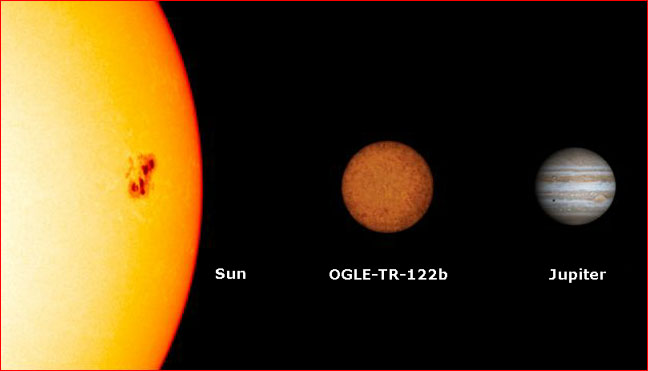
home •
about •
essential guide •
picture of the day •
thunderblogs •
news •
multimedia •
predictions •
products •
get involved •
contact

Credit: Sun image: SOHO/ESA; Jupiter: Cassini/NASA/JPL/University of Arizona/ESA.
pic of the day
archive
subject index
abstract
archive
Links:
Society for
Interdisciplinary
Studies
Mar 08, 2005
The Smallest Star
The picture above illustrates the relative size, compared to the Sun and Jupiter, of a recently discovered star – the smallest ever detected. Called OGLE-TR-122b, it is observed to cross in front of a Sun-like companion about once every seven days. The description of OGLE-TR-122b is enigmatic. Though it is only 16% larger than the gas giant Jupiter, astronomers say it is 96 times as "massive".
Astronomers describe the smallest star as a “core burning star,” like our Sun. But prevailing theory never anticipated such a diminutive star, since the standard fusion model of stars required a minimum gravitating mass considerably greater than that of Jupiter. To account for the highly anomalous object, and in particular the induced wobble in the motion of its larger companion, astronomers simply accepted what their model implied. While OGLE-TR-122b is only 16 % larger than Jupiter, it must contain 96 times the mass of Jupiter, and 50 times the density of the Sun!
Investigative team member, astronomer Claudio Melo of the European Southern Observatory in Santiago, Chile, summarizes the achievement of the small star this way: “Imagine that you add 95 times its own mass to Jupiter and nevertheless end up with a star that is only slightly larger …The object just shrinks to make room for the additional matter, becoming more and more dense.”
But this hypothesized feat of “shrinking” or “super-condensing” matter is merely hypothetical. Nothing of the sort has ever been achieved in laboratory experiments, and no one has ever observed such a thing anywhere in the natural world. Were the feat not required to save a theory, astronomers would have surely called it a “violation of the self-evident laws of physics.”
Another viewpoint is now well established, however. In this view the calculations of the mass of this dwarf star are highly inflated. They do not take into account the strong electromagnetic forces between the small star and its larger parent star. Nor does it factor in our profound ignorance of the nature of mass and gravity and its relationship to the electrical structure of matter.
In the Electric Universe model, gravitational distortion of atoms within a star gives rise to atomic electric dipoles that align to form a radial internal electric field. The electric field produces charge separation within a star on a scale that not only prevents further compression but also causes "splitting" or "parturition" of a star in a nova outburst if it becomes electrically or gravitationally destabilized. The standard stellar model, however, relies on the interior of stars obeying the perfect gas laws; which allows astrophysicists to dismiss internal charge separation (as Eddington did in his seminal work, The Internal Constitution of the Stars).
The result of electrical splitting is two energetic bodies of unequal size—a sun-like star and a smaller close-orbiting binary partner – as we see in this example. The electric birth of the companion star or gas giant will place it much closer to its parent than traditional gravity-based models had ever envisioned, or even considered possible. OGLE-TR-122b is not a super-dense companion, but is merely subject to stronger electromagnetic interaction with its parent star, due to the nature of its birth. Where the electric force is active in this way, Newtonian calculations of mass and density will always produce bizarre results.
Electrically, the standard “threshold mass” for a star is a meaningless concept. Stars do not have to ignite a fusion reaction in their core to produce their energy. They receive electrical power directly from cosmic Birkeland currents that thread the galaxy. And the nuclear reactions occur, not in the core, but in the bright photosphere of a star. (This is a testable claim if astronomers will ask the question).
Unfortunately, when orthodox theorists confront the failure of Newtonian concepts, they often turn first to panaceas, proposing mere abstractions such as “dark matter,” or "super-condensed, degenerate matter,” to save their theory. To the cosmic electricians, these “computer games” have no relationship to the verifiable dynamics of the natural world.
EXECUTIVE EDITORS:
David Talbott, Wallace Thornhill
MANAGING EDITOR: Amy Acheson
CONTRIBUTING EDITORS: Mel Acheson, Michael Armstrong, Dwardu Cardona,
Ev Cochrane, C.J. Ransom, Don Scott, Rens van der Sluijs, Ian Tresman
WEBMASTER: Michael Armstrong
Copyright 2005: thunderbolts.info